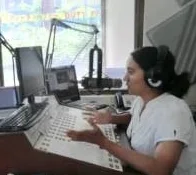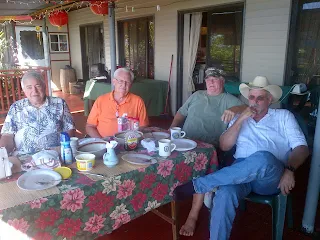Where it all began...
Went up to see Josephine Blanco Akiyama this past weekend and her husband Max, both from Saipan.
It was with Josephine that the story on Earhart on Saipan began back in the 1940's.
 |
| Josephine Blas Blanco as a young girl on Saipan. Photo courtesy JB Akiyama |
And continues to this day.
She wasn't the first person to see Amelia, of course. The Queen of Mili atoll saw her plane come down and land in Mili (Oliver Knagg's book), then Amelia was seen by Bilimon Amaron (later Jerry Kramer's business partner, who Jerry vouches for "100%") - she spoke to Bilimon in English, unfortunately he didn't speak English, but heard the crew calling her "Ameera." (his words).
Then we have a host of new people who've come forward who saw Amelia on Saipan - some say she was the "first caucasian woman" they'd ever seen, and that she was dressed like a man, so needless to say her appearance on Saipan - as it would be anywhere in the world - was something that everyone noted.
However, because of the time and place - Saipan - people were afraid to come forward and discuss it. Which I confirmed with an extensive interview with Ms. Akiyama - who at 87 recalls these events as if they were yesterday.
 |
| Tan Josephine today in Foster City |
She was a the daughter of Juan Blanco - a fairly well to do land owner who owned a ranch near Susupe, and two story large home in the heart of Garapan city. The Japanese had begun to populate Saipan in 1914, and it became Japanese territory. From all reports, people got along well with the Japanese, profited from the sale of sugar cane, tapioca and coconut, and Josephine's father would host large state dinners with Japanese dignitaries. Josephine met Emperor Hirohito's cousin
Kosho Otani on one such occasion when he visited Saipan prior to the war.
 |
| Mr. and Mrs. Juan Blanco. Photo courtesy JB Akiyama |
As a young girl, she enjoyed the wonderful beaches, going to the Catholic church (she is part Spanish and part Chomorro) and liked attending the local Japanese school, which was different from the "native" school where fellow Chomorro went... Until the new Japanese troops arrived. She doesn't remember exactly, but it was in the late 30's when these battle veterans (fighting in China since 1933) came, and took over for the teachers. These soldiers were "mean, cruel" and she recounts how one student refused to bow ("salute") a teacher properly and this teacher killed him. Threw him against a rock and broke his skull.
 |
The Blanco family, Josephine last row rear left. Korean
brother in law who forgot his lunch is the groom. Juan Blanco front row. Photo courtesy JB Akiyama |
(Later, that teacher was seen in the camp at Susupe, and Josephine remembered there was talk of murdering this man - Susupe was part of her family's property, and the US soldiers used it as a camp to gather all the surviving islanders, to feed and clothe them after the battle.)
 |
| Dinner for Japanese dignitaries in the Blanco Home. Photo courtesy JB Akiyama |
When Josephine was 11, in 1937, her sister asked her to deliver a lunch to her construction worker husband. Her sister was married to a Korean fellow who worked in construction. And he was currently working over near Tanapag Harbor (Ponte Mucho). There are subsequent reports that at this time the Japanese were fortifying the seaplane base there, perhaps that was form of construction he was engaged in. But either way, as a favor, Josephine agreed to ride her bike over to the construction site near the ocean and deliver his lunch.
 |
| Old Garapan City, and a typical bicycle on its dirt street. Photo courtesy JB Akiyama |
And as she rode there, she was a silver plane flying low off into the harbor. She said it was a plane unlike she had every seen before. (I asked if it could have been a seaplane - she said "perhaps.") The seaplane harbor was part of Tanapag Harbor, and if, as reported, Earhart came down in Mili, her wounds here tended to in Jaluit (as reported by Bilimon Amaron), it's conceivable that a seaplane picked her and Fred Noonan up and delivered her to Saipan. (And as we now know, the Electra was taken to Aslito airfield and stored in a hangar.)
 |
This was a hospital before and during the war,
now home to the CNMI Museum - one of our witnesses says his mom
heard about Amelia and Fred being treated here. Photo courtesy JB Akiyama |
But at this moment, all Josephine was aware of is that there is a commotion where the construction site is, and she got off her bike and went to deliver the lunch to the guard at the gate. And as she was telling him what the name of her brother in-law, about "25 yards" away, she saw a "tall, thin ash blonde haired woman dressed as a man," walking with an "equally tall skinny man." Josephine said she had "never seen a caucasian woman before" and that the even the Japanese guard said the words "woman" and "man" in Japanese with reference to the prisoners. As in "that is a woman and a man" ("Onna" and "Otoko" in Japanese) when he referred to the tall thin woman walking with the tall thin man.
 |
The Shinto Shrine. Prior to the war every single student had to go here at down and
"salute" bow down to the shrine whether they were Buddhists or not. It was near here that
a student was murdered for not saluting a teacher properly. Photo JB Akiyama |
Josephine went home and told her family about seeing this "caucasian woman dressed as a man" down near the construction site. She didn't hear anything else about the woman, of who she was (but of course, we have. Amelia was then seen at the "Kobyashi Hotel," at the hospital where her and Fred's wounds were attended to, and later at the jail in Garapan. We've heard of Fred's execution early on, and finally two reports of seeing Amelia on the same day on the back of a Japanese truck with her arms tied behind her back - in May of 1944, just days prior to the American invasion.)
 |
Dr. Schifft. Josephine is far right. She told Shifft about seeing the female
pilot dressed as a man, and he told Paul Briand. Photo JB Akiyama |
But when the war ended, Josephine went to work at a Dentist's office in Saipan, for a Dr. Schifft. And one day in 1946 he was talking about the rumors that a female pilot had been on Saipan, and Josephine offered her story of seeing her. Dr. Schifft took Josephine down to the harbor and asked her to point to where she saw the female pilot and tell the entire story. And then Dr. Schifft told that story to Paul Briand, who decided to write a book about it - by this time, in the 1950's, Josephine and her husband Max were living in California. Briand interviewed her and published her account in 1960 ("Daughter of the Sky").
 |
The Catholic Church - Japanese closed the church (turned it over to the military in the late 30's)
and no mass was allowed. Bodies were disinterred from the Catholic cemetery and put into another.
Note blue stamp - Japanese authorities ordered all photos to be checked and stamped. Photo JB Akiyama |
And then Fred Goerner tracked her down, interviewed her while he was a CBS correspondent, and did the legwork of going to Saipan many times to get more stories ("Searching for Earhart"). (Josephine remembered Goerner promised a copy of his book, but never sent it; Briand did.)
So here we are in 2013 interviewing a woman about what she saw, when she saw it, how she saw it. She told other stories about Saipan, all of which can be corroborated, about the war, about what happened to her family. The stories we've heard about the war are very common. She also told the dramatic story of having her home taken by the Japanese, how she snuck back into her home one day to get some fresh water and was almost executed, how she and her fellow students became slave workers for the military government, how they were abused - but also how when the shelling began, there was a moment when it looked like her family of ten would be killed by the falling bombs - and a Japanese soldier showed them an underground shelter -- which saved her life.
 |
| Josephine around the time she came to the States. Photo courtesy JB Akiyama |
"I love Japanese people. I married a Japanese man. I have nothing against the people of Japan," she said during her interview. I pointed out that the stories we've been gathering are the same - that the people of Japan and the people of Saipan have a shared history - and then for a short period of time, the government became a military one, and the abuse began. And how many young Japanese men left their homes and families to fight on Saipan and lose their lives, just as the Americans did. War is a matter of perspective, and we'd like to pay homage to all those individuals who lost their lives while fighting on Saipan.
Including Fred Noonan and Amelia Earhart.
 |
| Fred & Amelia. Photo Purdue Archive |
Their only crime was being in the wrong place at the wrong time. Their only crime was being American citizens. Its entirely possible that she was asked to spy for the government and that was the military nature of her journey - but that was only a small part of her accomplishment around the world. In 1937 spying was an act of war. So if her plane was equipped with Fairchild aerial surveillance cameras (as reported by one of our interviews with the son of the man who installed them), and she was picked up by the Japanese, she would have been considered a spy. Even if there was no footage in the camera. And the US couldn't reveal they knew she was on Saipan (we have one witness who claims his uncle was told to look for her), because it would have revealed that we had broken their code. (which the US had done in the 1930's).
Wrong place, wrong time.
But they both died patriots - because they were both killed for being Americans. Isn't it about time we honor that sacrifice?
Thank you Josephine for telling us this story on camera. Stay tuned...























































